
Booze, Sailors & Health Menu: 1 2 3 4 5 6 7 8 9 10 11 12 13 14 15 16 17 18 19 Next>>
Booze, Sailors, Pirates and Health In the Golden Age of Piracy, Page 7
Alcohol: Wine - Sacks: Malaga
Not far from Jerez and the triangle that composed its wine growing region in Spain was the city of Malaga. Like Sherry, Malaga wines were likely fortified. Samuel Pepys described his tasting experience at the behest of Captain George Cocke: "It was Malago Sack, which, he [Cocke] says, is certainly 30 years old, and I tasted a drop of it, and it was excellent wine, like a spirit rather than wine."1 This 'spirit' flavor was probably imparted by the brandy used to fortify the wine. The term 'sack' probably originated around the
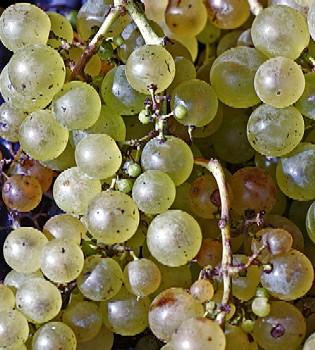
Photo: INRA DIST - Muscat Grapes
end of the fifteenth century, being derived from sacar, Spanish for 'to draw out', indicating it was exported.2
Today, Malaga wines are made from two white grape varieties: Pedro Ximénez and Moscatel. These are the same two grapes used to make the sweet sherries. Wine historian Cyrus Redding says that the Pedro Ximénez grape "was first brought to Malaga by a person of that name, two hundred and fifty years ago [~1600]. The skin is fine, and the fruit exceedingly sweet."3 However, he goes on to point out that at the time he was writing (1852), there were a "variety of Spanish vines, and [there is] slight distinction there is between them", noting that "Roxas Clemente describes one hundred and twenty species in Andalusia and Grenada alone."4 Andalusia encompasses all of southern Spain including the sherry grape growing areas. Redding mentions other grapes which were used in Malaga wines during that time including the white grapes Layrén, Doradillo, Larga, Bueno, Moscatel Grande and Moscatel Menudo Blanco.5 Like several other wines discussed, these wines would have been strong, sweet and high in alcohol content.
Malaga sack is mentioned by both sailor Edward Barlow, who was serving in the navy in 1661 aboard the Augustine, and by naval clerk John Baltharpe, who was serving on the St. John in 1670. Barlow was at Malaga, where he noted that they "had it cheap enough, giving but threepence
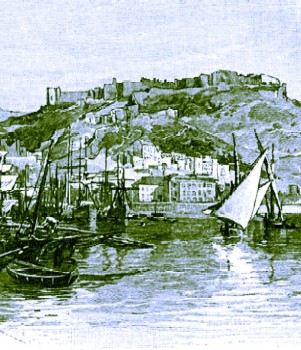
Malaga Harbor, From The Student's Cyclopedia, Vol. 2,
By C.B. Beach (1898)
halfpenny and a groat for a quart of good ‘Malego sack’. And I for my part drank very heartily, for it was very sweet and good"6. He must not have been prepared for a wine with such a high alcohol content, because he later says, "my head began to turn round, for it was got into my head before I was aware; but still I was a great deal better than some of them were."7 Baltharpe gives similar account of the wine the naval sailors drank while they were at Malaga in July of 1670 (in verse, naturally):
By reason fair wind we had got,
At that same time we Anchored not;
But there our Boat she went ashoar.
And Sack she brought Aboard good store:
That night there was some drunk, some sober,
And some were also half Seas over:
Some men would Prate beyond their skill,
When of this Sack, they'd got their fill.
And when you tell them on't next day,
They do not know then what you say.8
Medicinally, Malaga wines are specified in the make-up or administration of a couple different compound medicines found in the sea surgeon's medicine chests. These include Aqua Odifera (Sweet Water), Mithridate, Pulvis Arthriticus, Unguentum Mariatum (Soldier's Ointment) and Unguentum Potabile (Drinkable Ointment).
The surgeons sometimes employed sack when treating a patient. Sea surgeon John Moyle uses sack as a cordial when
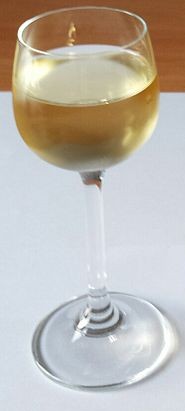
Photo: Xemenendura - Malaga Wine
discussing the treatment of fluxes or diarrheas.9 Following an amputation, French surgeon Ambroise Paré recommends a diet designed to rebuild the patient's strength which includes "bread tosted and dipped in Sacke or Muskedine."10 Sea surgeon John Atkins similarly advises giving sack to patients recovering from fractures, suggesting their diet incorporate "for a common Drink, Sack-Whey [fortified wine with whey (weak milk) and sugar]"11.
Physician Tobias Venner has much to say about the use of sack, beginning with its humoral properties: "Sack is compleatly hot in the third degree, and of thin parts, and therefore it doth vehemently and quickly heat the body"12. Hot medicines were generally used to treat illnesses believed to be caused by cold humors. He warned that "the much and untimely use of it, doth over-heat the liver [the body part believed to produce the blood humor], inflame the bloud [one of the bodily humors], and excicate [dry] the radicall humour in leane and dry bodies: wherefore to them that are young, and all such as are of any hot and dry temperature, it is greatly hurtfull."13 As mentioned, people were generally believed to have four temperaments - the hot and dry temperament was considered choleric or having an excess of the bodily humor yellow bile.
Venner goes on to say that "if it be moderately taken of them; for whom it is agreeable, it maketh the stomack strong to digest, helpeth the distribution of the meats [food] unto all parts of the body, concocteth crude humors [so they can be used by the body], and consumeth the excrementall [bad humors]; and to speak all in a word, it mightily strengtheneth all the powers and faculties of the body."14 He finishes noting that "It is chiefly to be drunken after the eating of meats of grosse Substance and such as it consist of an excrementall moysture, as Pork, Fresh-fish, etc."15
1 Samuel Pepys, The Diary of Samuel Pepys, Monday 20 July 1663, gathered 11/16/17; 2 Tim Unwin, Wine and the Vine, 2005, p. 193 3,4 Cyrus Redding, A History and Description of Modern Wines, 1851, p. 46; 5 Redding, pp. 46-7; 6,7 Edward Barlow, Barlow’s Journal of his Life at Sea in King’s Ships, East and West Indiamen & Other Merchantman From 1659 to 1703, p. 173; 8 John Baltharpe, The straights voyage, or, St. Davids poem, 1671, p. 51-2; 9 John Moyle, The Sea Chirurgeon, p. 175-6; 10 Ambroise Paré, The Apologie and Treatise of Ambroise Paré, p. 149; 11 John Atkins, The Navy Surgeon, p. 46; 12,13,14 Tobias Venner, Via Recta ad Vitam Longam, 1638, p. 30; 15 Venner, p. 30-1
Alcohol: Wine - Madeira
Madeira is an island about 450 miles off the coast of Morocco, Africa and almost 600 miles off
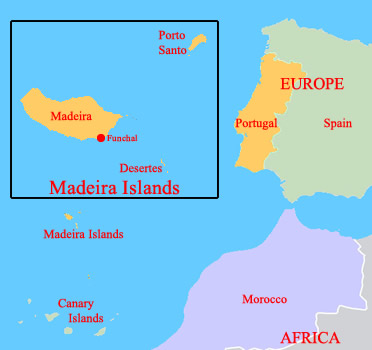
Madeira Islands Map
the coast of Portugal. It was discovered by Portuguese sailor João Gonçalves Zarco, who named it in reference to the dense forest he found there.1 (Madeira means 'wood' in Portuguese.) In an attempt to clear it of its dense forest, the Portuguese set fire to the woods. The ash resulting from these long-burning fires infused "the
permeable volcanic soil with potash, which by chance rendered
it particularly suitable for vine-growing."2
Madeira's location provided a convenient place for ships to stop when either going around Africa to the East Indies or across the Atlantic on the trade winds to the West Indies. As explained previously, the English relationship with other major wine suppliers France and Spain was rocky at various points during the golden age of piracy, which would seem to make ally Portugal an ideal supplier of wine.
Henry Jeffrys says that around 1687, Madeira wine on the island "would have been either white or a sort of rose colour known as partridge eye. It would have been dry, unfortified and unaged. In fact, it would probably have been rather harsh and acidic. Wines from Madeira are noted for their acidity which is partly why they last so long."3 Letters written by the Madeira-based wine merchant William Bolton Company between 1695 and 1714 mention a variety of wines being shipped around the world including a white beverage wine made from Verdelho grapes, very dark red wine called 'tint' or 'tent' made from Negro Molle grapes, highly prized red Malvasia (or 'Malmsey') wine and Vidonia wine.4
Brandy wasn't used to fortify Madeira at this point, although the Bolton letters do mention small quantities of it being made in the 18th century. Jeffreys explains, "What was added was calcium suphate or gypsum which helped fermentation, bolstered acidity and also led to brighter, clearer wines. It was an essential ingredient in madeira. Right from the beginning madeira was a manufactured wine."5
Wine historian Cyrus Redding noted that the first vines to grow in Madeira were probably
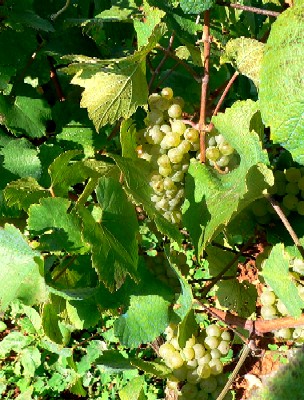
Malvasia Grapes on the Vine
transplanted Malvasia grapes.6 Writing in 1725, Physician Hans Sloane said that the island grew three kinds of grapes: "the White, Red and great Muscadine of Malvasia; of which the first are most plentiful"7. Historian David Hancock says that in 1703, there were four varieties of grape on Madeira - the three Sloane mentions and Vidonia (aka. Vidogne/Vidogna) - a 'black' grape.8 This corresponds to the wines shipped by the Bolton Company.
Sloane gives some insight into the types of wines made as well. He explains that "out of the White is made the greatest quantity of Wine, which is made Red by the addition of some Tinto [called by the Bolton letters 'tint' or 'tent'] , or very Red Wine made out of Red Grapes, which... helps it to preserve it self better."9
Sloane also notes an interesting property of some Madeiran wines. "The ...White mixt with a little Tinto ...has one very particular and odd Property, that the more 'tis exposed to the Sun-beams and heat, the better it is, and instead of putting it in a cool Cellar, they expose it to the Sun."10 He goes on to note that this wine "is Exported in vast quantities to the West-India Plantations, and now to the East [Indies]; no [other] sort of wine agreeing with those hot Places like this.11
There are some comments from the period about the flavor of Madeira wines; in his dictionary, John Stevens says that Madeira wine is strong.12 Sloane warns that the taste can be unpleasant to those not used to it, "though [it is] something like Sherry, to which Wine it comes near in Strength and other Properties."13
The flavor encountered on Madeira is probably not the same as that which the customers in the East and West Indies experienced. In making the long voyage to those destinations, the wine moving around in its wood container was being heated. As a result, some of the wine's acidity was probably removed by aging in the cask. Several authors suggest that Madeira merchant William Bolton mentioned 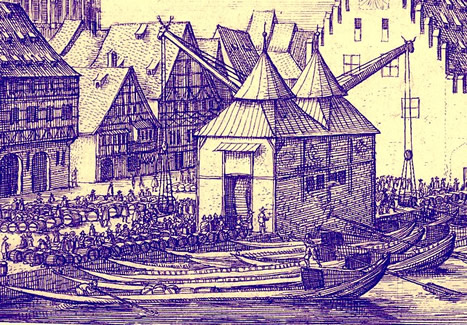
Artist: Wenceslas Hollar - Autumn, The Wine Market (Mid-17th Century)
'backloading' wine - shipping it to the tropics and back to Madeira to improve the flavor.14 However, while the two volumes of published Bolton Letters make no mention of this being done intentionally to improve the wine so it is not clear when this procedure began on Madeira.
Madeira wine is specifically mentioned in one naval account, one merchant account and five pirate accounts from the era15. Merchant to the East Indies pirates Adam Baldridge stated that he carried "Quarter Caskes of Madera Wine" for the needs of his thirsty, mostly pirate customers on Madagascar.16 Both pirate captains William Kidd and John Smith/Gow decided to stop at the island for a supply of wine during their pirating careers.17 Navy midshipmen Clement Downing, who was serving on the Salisbury, mentions that some of the men in the squadron sailing in the East Indies "disposed of several Casks of Arrack, and Madera Wine, &c. for very good Profit."18 In the same voyage, he mentions that when they encountered "former" pirate John Plantain and his men on Madagascar, "sold them several Hogsheads and Puncheons of Arrack, and Hampers of Wine [likely the same Madeira], for which they paid a very large Price, in Diamonds, and Gold Pieces of about 10 s. each."19 Blackbeard captured the Betty sloop in 1717, which he and his crew "did then and their Rob and Plunder of Certain Pypes of Medera Wine, and other goods and Merchandizes"20.
Madeira wine doesn't appear to have been of much use to the medical field during this time. Physician Sloane notes that, "The Wines from the Westward Isles are thought unwholesome, both because of the Grapes and mixture of Lime, Jesso, or Plaister, in making."21 However, he does mention treating a patient with 'dropsie' (edema) with "some Madera Wine, in which the Roots of Gentian, Tops of Centaury, &c. had been infused, with which Vomit, working easily, and the bitter Wine taken every morning for some days, he recovered his Stomach, and continued very well for a considerable time."22
1 "Madeira Wine: History of Madeira, Port of Funchal, & the Madeira Island Region", intowine.com, gathered 11/30/17; 2 Tom Stevenson, The New Sothebys Wine Encyclopedia, 2006, p. 340; 3 Henry Jeffreys, Empire of Booze, 2016, p. 96; 4 William Bolton & Andre L. Simon, The Bolton Letters, 1928, p.17; 5 Jeffreys, p. 97; 6 Cyrus Redding, A History and Description of Modern Wines, 1851, p. 262; 7 Hans Sloane, A Voyage to the Islands Madera, Barbados, Nieves, S. Christophers and Jamaica, Volume 1, 1725, p. 10; 8 David Hancock, "Commerce and Conversation in the Eighteenth-Century Atlantic: The Invention of Madeira Wine", Journal of Interdisciplinary History, Autumn, 1998, p. 204; 9,10,11 Hans Sloane, A Voyage to the Islands Madera, Barbados, Nieves, S. Christophers and Jamaica, Volume 1, 1725, p. 10; 12 John Stevens, “Madeira”, A New Dictionary, Spanish and English, and English and Spanish, 1726, not paginated;
13 Sloane, p. 20; 14 See for example Alexander Liddell, Madeira: The Mid-Atlantic Wine, 2014, p. 30 & Richard Mayson, Madeira: The islands and their wines, 2016; 15 Clement Downing, A Compendious History of the Indian Wars, 1737, p. 62, Thomas Phillips, 'A Journal of a Voyage Made in the Hannibal', A Collection of Voyages and Travels, Vol. VI, Awnsham Churchill. ed., p. 186, Daniel Defoe (Captain Charles Johnson), A General History of the Pyrates, Manuel Schonhorn, ed., 1999, p. 360, 442 & 470, Ed Fox, “63. Adam Baldridge: Deposition of Adam Baldridge, 5 May, 1699…", Pirates in Their Own Words, 2014, p. 347, Calendar of Virginia State Papers and Other Manuscripts, 1652-1781, William P. Palmer, ed., Vol. 1, 1875, p. 196; 16 Fox, p. 347; 17 Defoe (Captain Charles Johnson), p. 360 & 442; 18 Downing, p. 62; 19 Downing, p. 64; 20 Calendar of Virginia State Papers..., p. 196; 21 Sloane, p. xxviii; 22 Sloane, p. xcviii
Alcohol: Wine - Canary
The Canary Islands have apparently been populated since prehistory. Viticulture became a part of the islands produce with the conquest of the Spanish Castilians in the 15th century. Writing in 1661, Thomas Porter said,
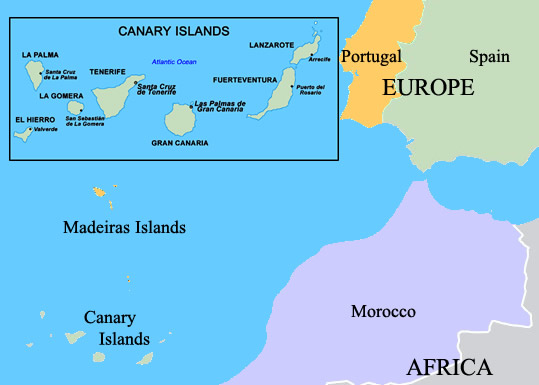
"Canary is plentiful in Barley, Sugar-canes, Honey, Wax, Kine, Camels, Goats, Woad for Dyers, and Canary Wine, which ...is now bought in such abundance (to supply Luxury) that (as it is reported) there are 3000 Tuns vended yearly into England and Holland."1
Unfortunately for the Canaries, this export all but ceased during the War of Spanish Succession when England and Spain were on opposite sides. As a result, "in 1701 English merchants were forced to depart from Tenerife. This coincided with an expansion in English imports of Portuguese wines"2. Still, like Madeira, the Canary Islands benefitted from being in a good location for ships heading to either the East and West Indies. The prohibition apparently didn't stop the English from stopping there for wine, either. In the beginning of his privateering voyage round the world begun in 1708, Woodes Rogers wrote "we agreed to pass by Maderas, and cruise a little amongst the Canary Islands for Liquor [referring to wine and possibly water], to prevent Loss of time"3.
If Rogers' statement lacks enthusiasm, it may have been because of the wine itself. Doctor Alexander Henderson wrote in 1824 that while Canary wines were made from the same sorts of grapes in the same soil as Madeira wines, "the Teneriffe wine has never the full body and rich flavor of the best growths of Madeira."4 Historian Tim Unwin says, "The dominant grape variety in Tenerife was the Malvasia, which had spread westwards from the Mediterranean, and produced the sweet white malmsey wines
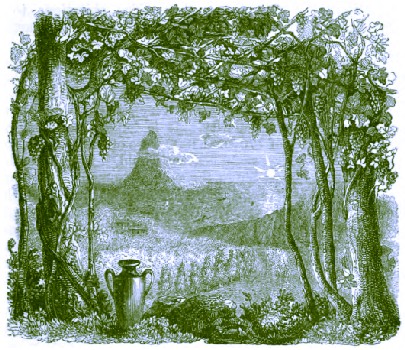
"The Atlantic Wines", From A History and Description of
Modern
Wines,
By Cyrus Redding (1851)
which were gaining such popularity in northern Europe during the sixteenth century."5 Physician Tobias Venner notes that Canary wine "is of some termed a Sack, with this adjunct sweet, but yet very improperly, for it differeth not only from Sack, in sweetnesse and pleasantnesse of tast, but also in colour and consistence: for it is not so white in colour as Sack, nor so thin in substance"6.
Merchant captain George Roberts says that Canary wines were not as popular in Barbados as Madeira. He explains, "the Inhabitants of this Island [Barbados], as likewise all our [English] Islands in the West-Indies, being for the most part used to Madera Wine, they did not seem to like so well our Canary Wine; nay, most of them were afraid to buy it, thinking it was not good, because different in Flavour from that of the Island of Madera, their accustomed Wine"7. He protests that the Canary wine costs twice as much as that from Madeira, "so it was of twice the Goodness of any Wine commonly brought from that Island, tho' it rather sold here under the Price of common Madera Wine."8 (Of course, any wine connoisseur will tell you that's not necessarily true.)
Henry Jeffrys suggests that one property that Canary wines doesn't share with Madeira is the
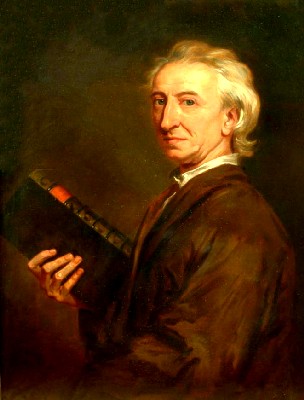
Artist: Sir Godfrey Kneller - John Evelyn (1687)
ability to improve when it is heated and moved. He says that this is "the reason it [Madeira wine] is still appreciated today when Canary isn't and why it became the most popular wine in British America and later India".9
Counter to this, we have a diary entry written by John Evelyn, a 17th century writer who served on the Navy's Sick and Hurt Commission during the Second and Third Dutch Wars. He explained that while visiting an East India vessel with the Duke of Ormond, "they gave us Canary [wine] that had been carried to and brought from the Indies, which was indeed incomparably good."10 So either Jeffreys is wrong, or Evelyn misidentified the wine he was given.
Canary wine appears in four sailor's accounts: Woodes Rogers' privateering voyage that was already mentioned, in Chaplain Henry Teonge's navy account and (by inference) in one of Edward Barlow's journal entries. Teonge discusses Canary four different times, once in conjuction with officer's evening celebrations11 and three times when he was dining with gentlemen of the local society while they exploring Turkey.12 Privateer George Shelvocke notes, "I sent my launch in chase of a small vessel discovered under the grand Canaries"13, which his men took, finding "a quarter cask of wine, the greatest part of which was drank by my boat's crew, before they brought their prize to the ship."14 Barlow says that the East Indiaman Medena had stopped at Grand Canary, but left behind 'several young men' who were "minding their own pleasure more than their business"15. (It could be argued that this refers to something other than drinking too much wine, but even if that is true, it seems likely that wine was at least part of the problem.)
If the sailors didn't appreciate it, Canary had some utility to the medical men of the period. It is included in the makeup
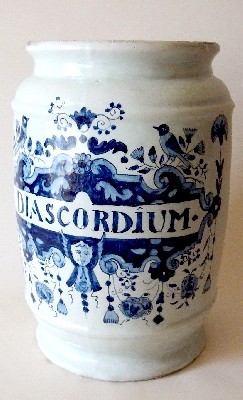
Diascordium Apothecary Jar
of several compound medicines which appear in the sea surgeon's books from the period: Aqua Theriacalis (Treacle Water), Electuarium Diascordium, Syrupus Croci (Syrup of Saffron), Theriaca Andromachi (Venice Treacle) and Vinum Benedictum (The Blessed Wine). Sea physician Thomas Aubrey treated a man with a 'diarrhoeic fever' with a medicinal decoction mixed in canary wine. The wine was primarily used to disguise the taste of the herbs in the medicine.14 Sea surgeon Hugh Ryder also mentions using it in the makeup of a balm called Balsamum Lucatelli15 in internal wounds of the torso.
Physician Tobias Venner claimed that Canary wine "is best agreeable to cold constitutions [one of the humoral temperaments discussed previously], and for old bodies, so that they be not too impensively cholerick [the warm and dry temperament, with an excess of the yellow bile humor]: for it is a wine that will quickly enflame, and therefore very hurtfull unto hot and cholerick bodies, especially if they be young."16 He specifically states that malmsey wine is "very hot, and by reason that it is sweet, it nourisheth very much, and therefore the use of it is exceeding profitable for old, cold, weake, and decayed bodies: for it mightily cherisheth the natural heat, and fortifieth all the powers of the body."17 He goes on to say that "It killeth wormes in children, by a certain naturall and hidden property, if they drink it fasting."18
The author of the Way to Health and Long Life adds that Canary wine "is an excellent Cordial Liquor, if a Glass is drank now and then, and will make a good Meal with a piece of Bread eat before your drink it."19 This agrees with Aubrey's comments.
1 Thomas Porter, A Compleat Delineation and Description of Several Regions & Countries in the Whole World, 1661, p. 75; 2 Tim Unwin, Wine and the Vine, 2005, p. 215; 3 Woodes Rogers, A Cruising Voyage Round the World, 1712, p. 14; 4 Alexander Henderson (MD.), The History of Ancient and Modern Wines, 1824, p. 254 5 Unwin,p. 213-4; 6 Tobias Venner, Via Recta ad Vitam Longam, 1638, p. 32; 7,8 George Roberts, The Four Years Voyages of Capt. George Roberts, 1726, p. 11; 9 Henry Jeffreys, Empire of Booze, 2016, p. 95; 10 John Evelyn, The Diary of John Evelyn, vol. 1, 1901, p. 356; 11 Henry Teonge, The Diary of Henry Teonge, Chaplain on Board H.M.'s Ships Assistance, Bristol, and Royal Oak, 1675-1679, 1825, p. 28; 12 Teonge, pp. 163 & 164; 13, 14 George Shelvocke, A Voyage Round the World by Way of the Great South Sea, 1726, p. 9; 15 Edward Barlow, Barlow’s Journal of his Life at Sea in King’s Ships, East and West Indiamen & Other Merchantman From 1659 to 1703, p. 428; 16 Thomas Aubrey, The Sea-Surgeon or the Guinea Man's Vadé Mecum, 1729, p. 81; 17 Hugh Ryder, New practical observations in surgery, 1685, p. 40; 18 Venner,p. 32; 19 Venner,p. 31; 20 Venner,p. 32; 21 The Way to Health and Long Life, 1726, p. 38
Alcohol: Wine and Health
Although the health benefits and detriments have already been discussed for each of the wines presented, there were a number of comments about the more generic classes of red and white wines in the health literature from the period. Physician Tobias Venner said of white wine,

Physician Tobias Venner (1660)
It is a great increaser of the vitall spirits, and a wonderfull restorer of all powers and actions of the body: it very greatly helpeth concoction [of food], distribution [of humors], and nutrition, mightily strengtheneth the naturall heat, openeth obstructions, discusseth windinesse, taketh away sadnesse, and other hurts of melancholy [humors], induceth boldnesse and pleasant behaviour, sharpneth the wit, abundantly reviveth feeble spirits, excellently amendeth the coldnesse of old age, and correcteth the tetrick [bitter or morose] qualities which that age is subject unto; and to speak all in a word, it maketh am an more courageous and lively both in mind and body1
He appears to be a fan. He notes that German ('Rhenish') and white wines
consist of a thin and penetrating substance, wherefore they are quickly concocted [digested], and very speedily distributed into all the parts of the body, and therefore they lesse annoy the head, than any other Wine. They cut and attenuate grosse [unusable] humors, provoke urine, and cleanse the bloud by the reines [kidneys]. They moisten the body, and cause sleepe, mitigate the paines of the head, proceeding from a great heat of the stomack2
Venner suggested that white wines were best for people who were "young, for hot constitutions, for hot Countries, and for the hot times of the yeere, and for those that would be leane and slender"3. In addition, he suggested that for good health, "It is very expedient to drink White-wine, or Renish-wine in the morning fasting, and also a little before Dinner and Supper, with a Lymon macerated [steeped] therein, and the juice pressed forth"4. However, he warned against drinking such wines with or after meals and explaining that they were "very pernicious for such as are Rheumatick, and subject to fluction
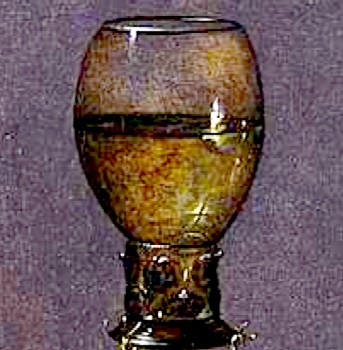
Artist: Cornelis Mahu - A Roemer of White Wine (1640)
of humors into the joynts, or other parts of the body, and therefore let such very carefully eschew the use of them."5
White wine is included in the makeup of a variety of medicines that were found in some of the sea surgeon's chests including: Aqua Cordial Fridga Saxony, Aqua Mirabilis, Dr. Stevens Water, Emplastrum de Betonica (Plaster of Betony), Emplastrum de Minio (Red Lead Plaster), Emplastrum de Ranis (Plaster of Frogs), Gargarismus ad Relaxio (Relaxing Gargle), Oleum Catellorum (Oil of Puppies), Oleum Lumbricorum (Oil of Earthworms), Polypodium, Syrupus Cynamoni and Syrupus Rosaceus Solutivus cum Sena. Sea surgeon John Moyle recommended a cathartic medicine containing white wine for use in fluxes (diarrheas).6
White wine has a wide variety of uses in medicine outside of these compounds. Physician Stephen Bradwell suggests it be heated and used to wash venemous stings7 and internally in drownings8 and poisonings.9 Military surgeon James Cooke uses it in a compound medicine designed to cure snake-bites.10 Physician Nicholas Culpeper advised his readers, "Decoctions made with Wine, last longer than such as are made with water... your best way it to make it with white Wine instead of water, because this is most penetrating."11 He also recommends wood betony taken "a dram of it at a time in white Wine" for headaches12.
Physician Venner seems to have had less use for red wine. He said it was "of an austere, sharp taste, of an astringent [contracting the body's tissues] faculty, and therefore only good for Physick [medicinal] uses, to stop cholerick vomitings, and fluxes of the belly."13 It was only used in one of the medicines found in the sea surgeon's dispensatory: Emplastrum Catagmaticum. However, it could also be used to color marshmallow or hollyhock root:
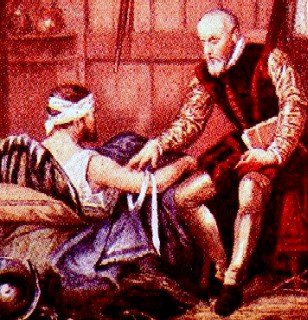
Artist: Eduoard Hamman
Surgeon Ambroise Paré Dressing a Soldier's Wound
"It [the root] is also used for rubbing the Teeth, in order to cleanse them, but in order to disguise it, it is tinged with a red Colour, by boiling it with red Sanders and some Alum, or with red Wine."14 Sea surgeon John Woodall suggested using it to hide the taste of crocus martis (saffron of iron) when treating diarrheas.15 Military surgeon Raymund Minderer likewise suggested it as a component of internal medicines for the same problem.16
Although red wine failed to have a significant place in internal medicines, it was widely used externally. In discussing the treatment of a chest wound, English surgeon Richard Wiseman recommends, "use Red wine, it being excellently good in such bleeding Wounds"17. When cleansing wounds caused by foreign objects such as arrows and bullets, Wiseman advised surgeons to "wipe away the clotted Bloud with a Sponge dipt in Red wine, Oxycrate [vinegar and water], or Water"18. French surgeon Ambroise Paré similarly suggested the use of bandages soaked in red wine or oxycrate for such wounds, "so to strengthen the part, and hinder defluxion [outflows from the wound]."19 He recommended the same procedure for bandaging fractures.20 Sea surgeon John Moyle21 and Wiseman22 both cleansed head wounds with a foment made from red wine. Moyle similarly recommended dressings applied to such wound be soaked in red wine23 as does Wiseman24. In a similar way, sea surgeon
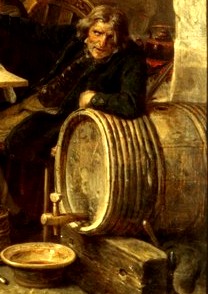
Artist: Bengt Nordenberg
Enjoying a Cask of Red Wine, From A
Revivalist
Disturbs the Merrymaking (1866)
John Atkins says when treating a dislocated hip, "I should think a Compress dipped in Oxycrate, or Red Wine, large enough to infold the whole Joint, and crossing upon the Hip, would be better than Emplaisters"25. He suggests the same thing for a luxation of the shoulder.26 For wounds to the internal organs, Wiseman stated "if the Gut be so pus[h]t out [through a wound] that you cannot return it in, you ought to foment it with warm Water, Red wine, or some discutient [dissipating] Decoction".27
Venner had some general comments relating to wines in conjunction with health. He warned that "wines that are new, are unwholsome: for they have in them little heat, and consist of a grosse and excrementall substance: wherefore they doe not help, but much hinder the concoction [of food] and distribution [of the humors generated by the food], cause fluctuations in the body, and cholick-torments, and abundantly breed obstructions of the liver, milt [spleen] & reines [kidneys]."28 However, as they aged, they become "more hot, more pure, and much more wholesome."29
Venner also warned against drinking too much wine, asking "what can be more hurtfull than Wine, seeing that the same immoderately taken, destroyeth the life and prosperous health, disturbeth the reason, dulleth the understanding, confoundeth the memory, causeth the Lethargie, Palsie, trembling of the hands, and a general weaknesse of the sinewes?" 30
1 Tobias Venner, Via Recta ad Vitam Longam, 1638, p. 27; 2,3,4 Venner, p. 28; 5 Venner, p. 29; 6 John Moyle, The Sea Chirurgeon, p. 170-1; 7 Stephen Bradwell, Helps For Suddain Accidents Endangering Life, 1633, p.39 & 47; 8 Bradwell, p. 17; 9 Bradwell, p. 100; 10 James Cooke, Mellificium Chirurgiæ: Or, The Marrow of Chiururgery, 1693, p. 111; 11 Nicholas Culpeper, The English Physitian Enlarged, 1666, p. 277; 12 Nicholas Culpeper, A Pharmacopoeia Londeniis, 1720, p. 21; 13 Venner, p. 34; 14 Robert James, Pharmacopoeia Universalis, 1747, p. 223; 15 John Woodall, the surgions mate, p. 213; 16 Raymund Minderer, A Body of Military Medicines Experimented, Volume 4 of Paul Barbette's, Thesaurus Chirurgiæ, The Fourth Edition, p. 71; 17 Richard Wiseman, Several Chirurgicall Treatises, 1686, p. 435; 18 Wiseman, p. 341; 19 Ambroise Paré, The Workes of that Famous Chirurgion Ambrose Parey, 1649, p. 319; 20 Paré, p. 169-70; 21 John Moyle, Memoirs: Of many Extraordinary Cures, 1708, p. 26; 22 Wiseman, p. 382; 23 Moyle, pp. 3, 14 & 25; 24 Wiseman, p. 380; 25 John Atkins, The Navy Surgeon, 1742, p. 108; 26 Atkins, p. 105; 27 Wiseman, p. 371; 28, 29 Venner, p. 34; 30 Venner, p. 27

